Getting started with Machine Learning in OpendTect
To get started with Machine Learning in OpendTect several datasets are provided on TerraNubis with wich all plugins are available for all users. There is of course F3 offshore the Netherlands, Penobscot and recently two more sets were added in support of FORCE competition.
Follow the steps below to install OpendTect 7.0 and download the complete datasets.
- Step 1: Download the installer for Opendtect 7.0
- Step 2: Download the free datasets on TerraNubis
 OpendTect Machine Learning Developers' Community on Discord
OpendTect Machine Learning Developers' Community on Discord
Join the OpendTect Machine Learning Developers' Community on Discord.
For more information on how to become a member and be part of the Community please read the FAQ.
Blogs
Machine Learning Workflow Blogs
| Publish Date | Author | Title | Resources |
|---|---|---|---|
| 02 March 2023 | Paul de Groot | Machine Learning Workflows – Quick UVQ Waveform Segmentation | Video |
| 23 March 2023 | Paul de Groot | Machine Learning Workflows - Using AI for Salt Detection | Video |
| 30 March 2023 | Marieke van Hout | Machine Learning Workflows - Ready to go AI workflows - Apply Pre-trained Model | Video |
| 06 April 2023 | Paul de Groot | Machine Learning Workflows - Fast and Simple Seismic Facies Analysis - 3D UVQ Waveform Segmentation | Video |
| 20 April 2023 | Paul de Groot | Machine Learning Workflows - De-risking charge and seal issues with AI - Neural Network Chimney Cube | Video |
| 04 May 2023 | Paul de Groot | Machine Learning Workflows - Seismic Inversion using AI - Machine Driven Seismic Inversion Workflow | Video |
| 25 May 2023 | Paul de Groot | Machine Learning Workflows - Supervised AI Seismic Facies | Video |
Machine Learning Blogs
- OpendTect Patch Release 7.0.8 (Releases) November 20, 2024
- OpendTect Patch Release 7.0.7 (Releases) October 8, 2024
- OpendTect Patch Release 7.0.6b (Releases) July 25, 2024
- OpendTect Patch Release 7.0.6 (Releases) July 16, 2024
- OpendTect Patch Release 7.0.5 (Releases) May 1, 2024
- Lessons learnt for tuning a Machine Learning fault prediction model (News) February 13, 2024
- OpendTect Patch Release 7.0.4 (Releases) February 6, 2024
- Creating labels for supervised geoscience applications (Functionality, features and workflows ) January 18, 2024
- odbind Python Module - an open source Python binding to OpendTect project data (Webinars) January 11, 2024
- Can AI Outshine Human Expertise in Seismic Analysis? (Functionality, features and workflows ) October 19, 2023
- Join us at the SBGf International Congress in Rio de Janeiro Brazil from October 16th to 19th, 2023! (Events) October 5, 2023
- Join us for an Exclusive Presentation on Seismic Diffraction Imaging in Malaysia! (Events) September 28, 2023
- Introducing our new Pre-trained Fault model (Fault Net) (Functionality, features and workflows ) September 21, 2023
- Optimizing Thinned Fault Likelihood (TFL) through Advanced Filtering and Computing RMS of TFL (Functionality, features and workflows ) September 14, 2023
- Machine Learning Data Enhancement of 2D Seismic (Functionality, features and workflows ) September 7, 2023
- Come see us at IMAGE ‘23 and check out what’s new in OpendTect 7! (Events) August 17, 2023
- OpendTect Noise Filters Comparison: Cast your preference (Functionality, features and workflows ) July 27, 2023
- Pioneering in Machine Learning (General) July 20, 2023
- OpendTect Pro supports two OSDU formats: OpenVDS and OpenZGY (Functionality, features and workflows ) July 13, 2023
- Have you upgraded to version 7 yet? (Releases) June 29, 2023
- Two free ML webinars back to back (Webinars) June 15, 2023
- Free webinar on 'Machine Learning and OpendTect: Building and Training your 2D CNN Model' (Webinars) June 9, 2023
- New Major OpendTect release (Events) June 1, 2023
- Machine Learning Workflows - Supervised AI Seismic Facies (Functionality, features and workflows ) May 25, 2023
- Free webinar on Approaches to Data Conditioning in OpendTect (Webinars) May 17, 2023
- Machine Learning Workflows - Seismic Inversion using AI - Machine Driven Seismic Inversion Workflow (Functionality, features and workflows ) May 4, 2023
- Machine Learning Workflows - De-risking charge and seal issues with AI - Neural Network Chimney Cube (Functionality, features and workflows ) April 20, 2023
- Machine Learning Workflows - Fast and Simple Seismic Facies Analysis - 3D UVQ Waveform Segmentation (Functionality, features and workflows ) April 6, 2023
- Machine Learning Workflows - Ready to go AI workflows - Apply Pre-trained Model (Functionality, features and workflows ) March 30, 2023
- Machine Learning Workflows - Using AI for Salt Detection (Functionality, features and workflows ) March 23, 2023
- Machine Learning Workflows – Quick UVQ Waveform Segmentation (Functionality, features and workflows ) March 2, 2023
- XGBoost NPHI Prediction (Functionality, features and workflows ) February 23, 2023
- Finding Hydrocarbons with OpendTect's Fluid Contact Finder and Chimney Cube (Functionality, features and workflows ) February 9, 2023
- Improving interpretability with Machine Learning (Functionality, features and workflows ) October 27, 2022
- High-Resolution 3D Waveform Segmentation (Functionality, features and workflows ) September 8, 2022
- 5 Online Training Courses in one week - 26th to 30th September (Webinars) August 29, 2022
- dGB Earth Sciences at IMAGE 2022 - Houston (Events) August 25, 2022
- Machine Learning: Lundin GeoLab SimpleDenoise (Releases) August 4, 2022
- AJAX, an ML model to enhance the visual quality and interpretability of 3D seismic (Releases) July 28, 2022
- Desmile; another pearl in OpendTect’s library of pre-trained Machine Learning models (Releases) July 21, 2022
- Sharing Trained Machine Learning Models is Redefining our Modus Operandi (Releases) July 14, 2022
- OpendTect patch release 6.6.8 (Releases) July 14, 2022
- PyTorch added as development environment in OpendTect (Developers) July 7, 2022
- Sharing Trained Machine Learning Models will redefine our modus operandi (Events) June 2, 2022
- Integrated Machine Learning Rock Property Prediction Workflow (Functionality, features and workflows ) April 21, 2022
- Fault Dip and Azimuth for Machine Learning Fault Likelihood (Functionality, features and workflows ) April 14, 2022
- High-resolution unsupervised 3D segmentation of waveforms for quick geomorphological analysis - Free webinar (Webinars) April 7, 2022
- OpendTect Technology - Webinar series 2022 (Webinars) March 17, 2022
- Machine Learning Fault Prediction Challenge (Competition) July 22, 2021
- One-day, in-person advanced and introduction courses are back in Houston, for as little as 250 USD per seat! (Training) July 1, 2021
- Join our Machine Learning challenge on a brand new free dataset from Delft, The Netherlands (Competition) June 29, 2021
- We are excited to invite you to join our OpendTect Machine Learning Developers’ Community! (Developers) June 10, 2021
- The FORCE Machine Learning competition 2020 (Competition) July 21, 2020
- OpendTect Technology - Webinar series 2020 (Webinars) May 21, 2020
- MOL sponsors Machine Learning Project in OpendTect Pro (News) July 2, 2018
- Press: dGB Earth Sciences announces the release of the fully integrated E&P Machine Learning Platform (News) January 26, 2018
Code examples
On the OpendTect-ML-Dev GitHub repository you can find examples on how to develop your own Machine Learning tools and workflows as presented in the Machine Learning webinar videos. We will keep updating this GitHub repository with relevant content.
- Download the examples and PowerPoint used in the webinar of 22nd of April 2021 by David Markus that was about develop your own Machine Learning tools and workflows with OpendTect
- Download the Jupyter Notebook and images used in the webinar of 29nd of April 2021 by FORCE 2020 Machine Learning winner Olawale Ibrahim that was about how to prepare well logs to get optimal Machine Learning results.
- Download the Jupyter Notebook used in the webinar of 22nd of September 2021 by Friso Brouwer that was about how to extract data from OpendTect into a Python environment by coding in Jupyter Notebook.
- Download the Jupyter Notebook used in the webinar of 17th of February 2022 by Olawale Ibrahim, dGB Earth Sciences and Sergey Tsimfer, GazProm Neft. The webinar was about Porting Machine Learning horizon tracking Notebook to OpendTect.
- Download the Jupyter Notebooks and Python script used in the webinar of 15th of June 2023 by Hadyan Pratama, dGB Earth Sciences. The webinar was about Building and Training your 2D CNN Model with OpendTect.
Documentation
User documentation
| Machine Learning User Documentation |
System Requirements
| Machine Learning System Requirements for Windows | |
| Machine Learning System Requirements for Linux |
Development
| Develop your own models documentation | |
| dgbpy framework Documentation | |
| odpy framework Documentation |
Workflows
FAQ
How do I use Machine Learning in OpendTect?
Please refer to the documentation available in the resources below:
I want to use the ‘old’ NeuralNetworks plugin. Where can I find it?
In OpendTect 7.0 and 6.6, the ‘old’ NeuralNetworks plugin is now nestled inside the Machine Learning Control Center. It functions in exactly the same way as did the standalone NN plugin in OpendTect 6.4 and previous versions.
Is there an overview page of all the OpendTect Machine Learning knowledge?
Yes, please visit the following page. On this page one can find links to the OpendTect 7.0 installer, links to free datasets, video links, links to documentation (user, development and workflows, a link to this FAQ and links to code examples and data:
Is it possible to develop your own Machine Learning models?
Yes, this is possible. You can read documentation online, view webinar videos and download example code from GitHub:
- Develop your own models documentation
- Machine Learning Webinars: Part 5: Creating and Adding New Models
- OpendTect Webinar: Develop your own Machine Learning tools and workflows with OpendTect
- OpendTect Webinar: How to prepare well logs to get optimal Machine Learning results
- OpendTect-ML-Dev GitHub repository
To develop in OpendTect - Machine Learning, do I need a license for OpendTect Pro and the Machine Learning plugin?
No, you do need to install OpendTect Pro and Machine Learning, but you can develop new Machine Learning models and workflows that can be tested on a number of free datasets that can be downloaded from our TerraNubis portal. These special datasets do not check for licenses.
Can I test my models free-of-charge on my own datasets?
Yes, this is possible if you are willing to release the datasets under the Creative Commons License via TerraNubis. If you cannot share the data, you need a license for OpendTect Pro and Machine Learning. Commercial users can get licenses from the OpendTect Pro store. Universities can get free licenses under our Academic License Agreement (apply here).
What are my options for sharing trained models?
Our goal is to build a world-class library with trained models that can be imported into OpendTect - Machine Learning so users can apply these to solve similar problems on their own datasets. You have complete freedom to decide if you want to share your trained model free-of-charge and in the public-domain, licensed on your own defined commercial terms, or to keep your model proprietary. If the model will have a license, please be sure to include that in a license text file included with your submissions. Models without licenses will be assumed to be in the public-domain.
Why does the GPU not use all its resources during certain Machine Learning processes?
Within the Machine Learning plugin, it is the Python application that is running either the training or the prediction, not OpendTect itself. Within Python, the performance and behavior of each process (training/prediction) depends entirely on the python module being used: It will be very different between Sklearn (CPU only, very small memory footprint), and Tensorflow (GPU or CPU, large memory utilization).
We keep monitoring any available update for these Python packages and will implement these newer, improved versions immediately as they become available.
GitHub Repositories
| dgbpy is a framework for research and deployment of machine learning models from seismic and well data |
| odpy is a framework for research and deployment that allows for basic interactions with the OpendTect software and database |
| OpendTect-ML-Dev contains examples on how to develop your own Machine Learning tools and workflows. Also it includes examples used in webinars. |
Published articles
de Groot, P. and van Hout, M., [2021] Filling gaps, replacing bad data zones and super-sampling of 3D seismic volumes through Machine Learning. EAGE 2021 Annual Conference, Oral presentation in Digitalization & AI: Seismic Data Processing I, Tuesday, 19 October 2021 at 14:45.
Jaglan, H., Kocsis, G., Lakhliffi, A., and de Groot, P. [2021] Experiences with Machine Learning and Deep Learning Algorithms for Seismic, Wells and Seismic-to-Well Applications. EAGE 2021 Annual Conference, Oral presentation in Digitalization & AI: Reservoir and Wells, Thursday, October 21, 2021 at 15:55.
Saadat, M., Hashemi, H., Nabi-Bidhendi, M. and de Groot, P., [2021] Incorporating acquisition geometry in deep learning-based full waveform inversion. EAGE 2021 Annual Conference, E-Poster: FWI and Velocity Analysis. Geophysics 2, Thursday, October 21, 2021, 8:30 AM - 11:30 AM
de Groot, P., Pelissier, M., Refayee, H., and van Hout, M., [2021]. Deep Learning Seismic Object Detection Examples. DEW Journal, July 2021
Download PDF
de Groot, P., Pelissier, M., and van Hout, M., [2021]. Seismic classification: A Thalweg tracking/machine learning approach. First Break, Vol. 39, pg. 59-64, March 2021.
Gogia, R., Singh, R., de Groot, P., Gupta, H., Srirangarajan, S., Phirani, J. and Ranu, S. [2020]. Tracking 3D Horizons with a New, Hybrid Tracking Algorithm. Interpretation Journal, Nov. 2020.
Kocsis, G. and Jaglan, H. [2019]. Pseudo-Wells based HitCube 'trace-matching' and Machine Learning Inversions: Seismic Reservoir Characterization in a Challenging Environment. EAGE Subsurface Intelligence Workshop, Bahrain.
Download PDF
Kumar, P. C., Sain, K., and Mandal, A. [2019]. Delineation of a buried volcanic system in Kora prospect off New Zealand
using artificial neural networks and its implications. Journal of Applied Geophysics 161, p. 56 - 75
Download PDF
Refayee, H., and Hemstra, N., [2019]. The Use of Machine Learning to Enhance Faults and Fractures Detection in Seismic Data. 1st Applied Geoscience Conference
Download PDF
Rimaila, K., [2019]. Interpretation of Hydrocarbon Migration Pathways Using Latest Developments in Machine Learning - Green Canyon, Gulf of Mexico. GeoGulf (GCAGS; Gulf Coast Association of Geological Societies)
Download PDF
Singh, D., Kumar, P.C. and Sain, K. [2016]. Interpretation of gas chimney from seismic data using artificial neural network: A study from Maari 3D prospect in the Taranaki basin, New Zealand. Journal of Natural Gas Science and Engineering.
Download PDF
Rimaila, K., Mustaqeem, A. and Baranova, V. [2015]. Neural Network Application of Curvature Attribute for Fracture Analysis. GeoConvention 2015: New Horizons.
Download PDF
Rahimi Zeynal, A., Aminzadeh, F. Clifford, A. [2012]. Combining Absorption and AVO Seismic Attributes Using Neural Networks to High-Grade Gas Prospects. SPE Western Regional Meeting, Bakersfield, California.
Download PDF
Brouwer, F.C.G., Connolly, D. and Tingdahl, K. [2011]. A Guide to the Practical Use of Neural Networks.
Download PDF
Hashemi, H., Tax, D.M.J., Duin, R.P.W., Javaherian, A. and De Groot, P. [2008]. Gas chimney detection based on improving the performance of combined multilayer perceptron and support vector classifier. Nonlinear Processes in Geophysics, Volume 15, 863-871.
Download PDF
Aminzadeh, F. and De Groot, P. [2005]. A neural networks based seismic object detection technique. SEG Technical Program, Expanded Abstracts, p.775-778.
Download PDF
Aminzadeh, F., Ross, C. and Brouwer, F. [2005]. Assessing hydrocarbon risk with neural network classification methods. EAGE 67th Conference & Exhibition Madrid, Spain.
Download PDF
Aminzadeh, F. and De Groot, P. [2004]. Neural network applications. In: Aminzadeh, F., De Groot, P. and Wilkinson, D. (Eds.) Soft computing for qualitative and quantitative seismic object detection and reservoir property prediction. First Break.
Buy article
De Groot, P., Ligtenberg, H., Oldenziel, T., Connolly, D. and Meldahl, P. (Statoil). [2004]. Examples of multi-attribute, neural network-based seismic object detection. In: Davies, R.J., Cartwright, J.A., Stewart, S.A, Lappin, M. and Underhill, J.R. (Eds.) 3D Seismic Technology; Application to the Exploration of Sedimentary Basins. GS Memoir No. 29.
Download PDF
Heggland, R. [2004]. Definition of geohazards in exploration 3-D seismic data using attributes and neural-network analysis. AAPG Bulletin, Special Theme Issue: High-resolution studies of continental margin geology and geohazards, Volume 88, No. 6.
Download PDF
Ligtenberg, H. [2004]. Sealing quality analysis of faults and formations by means of seismic attributes and neural networks. EAGE Proceedings of Fault and Top Seals conference, Montpellier.
Buy article
Ligtenberg, H. [2003]. Sealing quality analysis of faults and formations by means of seismic attributes and neural networks. EAGE Fault and Top Seal conference, Montpellier, France, Extended abstract.
Download PDF
Ligtenberg, H. [2003]. Unravelling the petroleum system by enhancing fluid migration paths in seismic data using a neural network based pattern recognition technique. Geofluids magazine, 3, p.255-261.
Download PDF
Ligtenberg, H. and Wansink, G. (formerly dGB). [2002]. Neural network prediction of permeability in El Garia Formation, Ashtart oilfield, offshore Tunesia. In: Nikravesh, M., Aminzadeh, F. and Zadeh, L.A. (Eds.) Soft computing and intelligent data analysis in oil exploration. Developments in Petroleum Science, Volume 51, Chapter 19, p.397.
Download PDF
Ligtenberg, H. and Wansink, G. (formerly dGB). [2001]. Neural network prediction of permeability in El Garia Formation, Ashtart oilfield, offshore Tunesia. Journal of Petroleum Geology JPG, vol.24(4), p.389.
Download PDF
Wansink, G. (formerly dGB), Yang, L. (Sintef), et al. [2001]. A new confidence bound estimation method for neural networks, an application example. 63rd EAGE conference, Amsterdam.
Download PDF
Aminzadeh, F., et al. [2000]. Reservoir parameter estimation using a hybrid neural network. Computer and Geoscience.
Download PDF
De Groot, P. and Bril, A. [2000]. dGB-GDI Concepts & theory.
Download PDF
Heggland, R. (Statoil), Meldahl, P. (Statoil), Bril, A. and De Groot, P. [2000]. Detection of Seismic Chimneys by neural networks, a New Prospect Evaluation Tool. 62nd EAGE conference, Glasgow.
Download PDF
Meldahl, P. (Statoil), Heggland, R. (Statoil), Bril, B. and De Groot, P. [2000]. Semi-automated detection of seismic objects by directive attributes and neural networks, method and applications. 62nd EAGE conference, Extended abstract, Glasgow.
Download PDF
Oldenziel, T., De Groot, P. and Kvamme, L. (formerly Statoil). [2000]. Neural network-based prediction of porosity and water saturation from time-lapse seismic; a case study. First Break.
Yang, L. (Sintef), et al. [2000]. An evaluation of confidence bound estimation methods for neural networks. ESIT.
Download PDF
De Groot, P. [1999]. Seismic Reservoir Characterisation Using Artificial Neural Networks. 19th Mintrop seminar, Muenster, Germany.
Download PDF
De Groot, P. [1999]. Volume Transformation by way of Neural Network Mapping. 61st EAGE Conference, Helsinki.
Download PDF
Meldahl, P. (Statoil), Heggland, R. (Statoil), De Groot, P. and Bril, A. [1999]. The chimney cube, an example of semi-automated detection of seismic objects by directive attributes and neural networks: Part 1; Methodology. 69th SEG conference, Houston.
Buy article
Meldahl, P. (Statoil), Heggland, R. (Statoil), De Groot, P. and Bril, A. [1999]. The chimney cube, an example of semi-automated detection of seismic objects by directive attributes and neural networks: Part 2; Interpretation. 69th SEG conference, Houston.
Buy article
El Oul, J. [1998]. Neural networks introduction.
Download PDF
Braunschweig, B., Bremdal, B.A. and De Groot, P. [1996]. Neural Network experiments on synthetic seismic data. Artificial Intelligence in the Petroleum Industry, p. 93 - 124.
Download PDF
De Groot, P.F.M., Campbell, A.E., Kavli, T. and Melnyk, D. [1993]. Reservoir characterization from 3D seismic data using artificial neural networks and stochastic modelling techniques. 55th EAGE Conference, Stavanger.
Download PDF
Videos
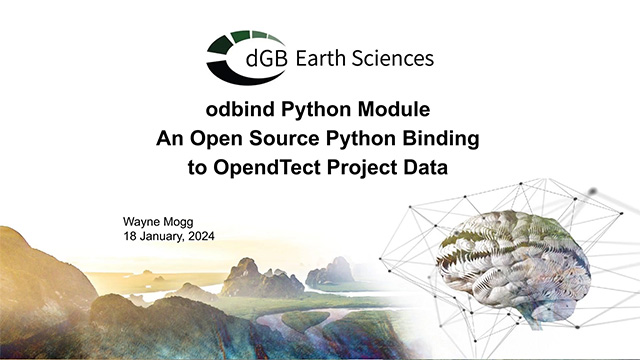
Published: 18 January 2024
OpendTect Webinar: odbind Python module an open source Python binding to OpendTect project data
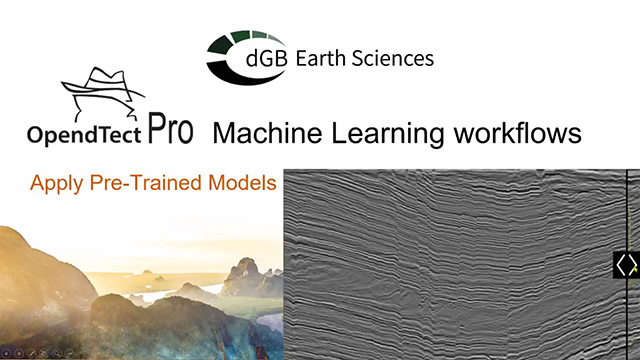
Published: 17 April 2023
Machine Learning Workflows - Ready to go AI workflows - Apply Pre-trained Model
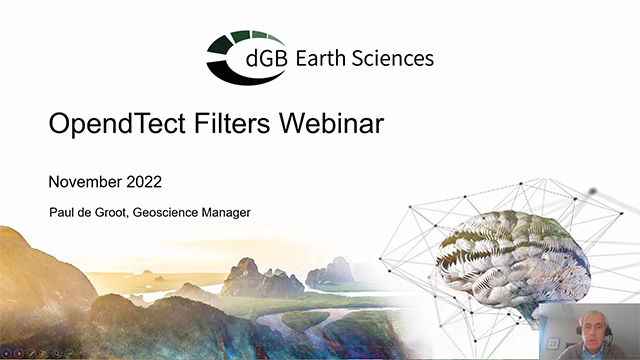
Published: 18 November 2022
OpendTect Webinar: Cleaning up your data - Dip steering and other filters

Published: 25 March 2022
OpendTect Webinar: Accelerating the Time from Machine Learning R&D to Deployment
Published: 17 February 2022
OpendTect Webinar: Porting Machine Learning horizon tracking Notebook to OpendTect
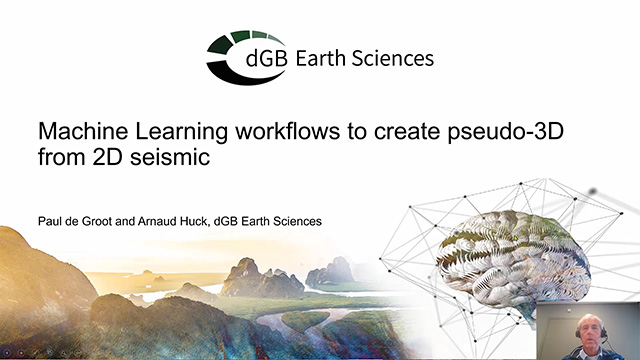
Published: 16 December 2021
OpendTect Demo: Machine Learning workflows to create pseudo 3D from 2D seismic
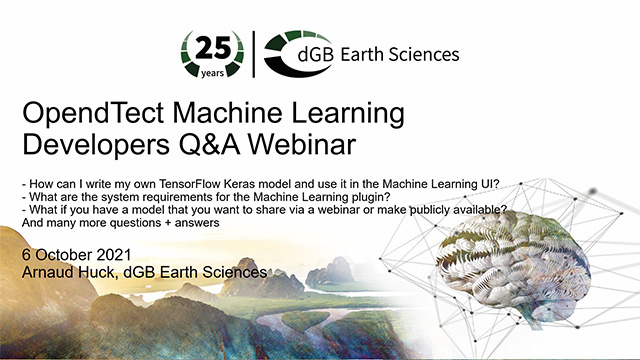
Published: 07 October 2021
OpendTect Machine Learning Developers Q&A Webinar: how to use my own Keras model in the ML UI?
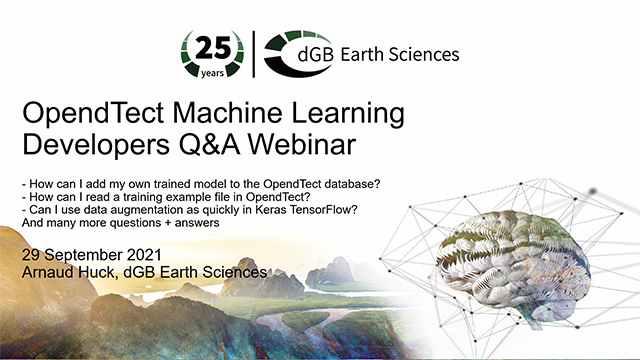
Published: 30 September 2021
OpendTect Machine Learning Developers Q&A Webinar: how can I add my own trained model and other Q+A

Published: 29 April 2021
OpendTect Webinar: How to prepare well logs to get optimal Machine Learning results

Published: 22 April 2021
OpendTect Webinar: Develop your own Machine Learning tools and workflows with OpendTect
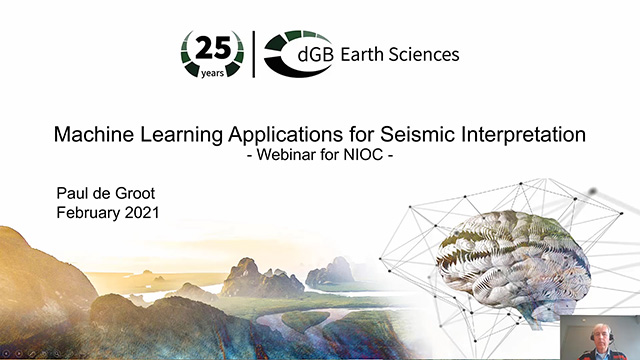
Published: 26 February 2021
OpendTect Webinar: Machine Learning Applications for Seismic Interpretation
Published: 26 February 2021
OpendTect Webinar: Seismic Classification: a Thalweg Tracker / Machine Learning Approach
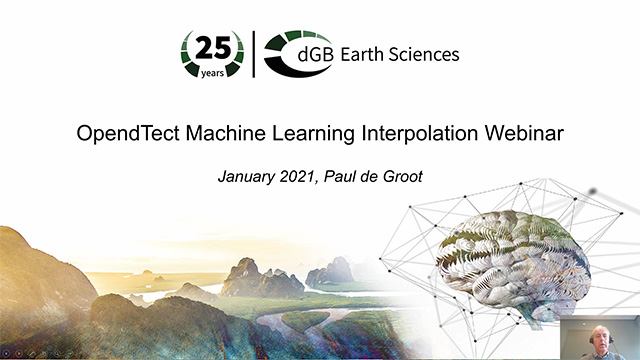
Published: 29 January 2021
OpendTect Webinar: Machine Learning workflows for seismic data interpolation
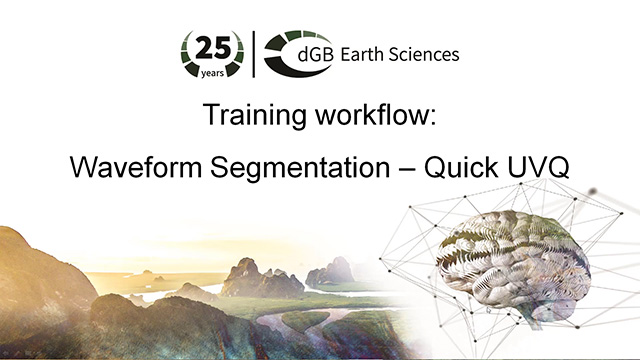
Published: 24 November 2020
Training workflow: Pattern Recognition - Waveform Segmentation - Quick UVQ
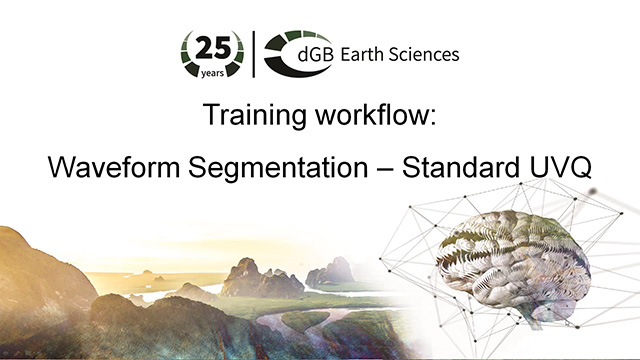
Published: 24 November 2020
Training workflow: Pattern Recognition - Waveform Segmentation - Standard UVQ
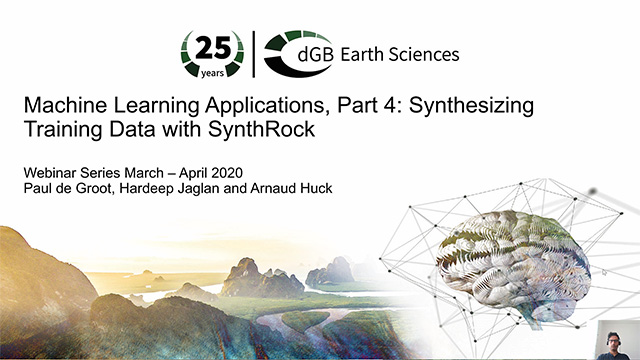
Published: 16 April 2020
Machine Learning Webinars: Part 4: Synthesizing Training Data with SynthRock
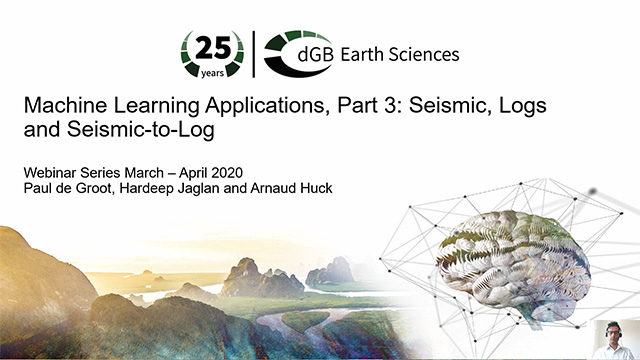
Published: 09 April 2020
Machine Learning Webinars: Part 3: Applications: Seismic, Logs, and, Seismic-to-log
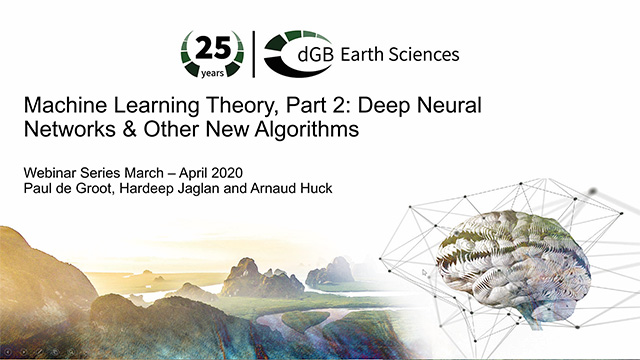
Published: 02 April 2020

























